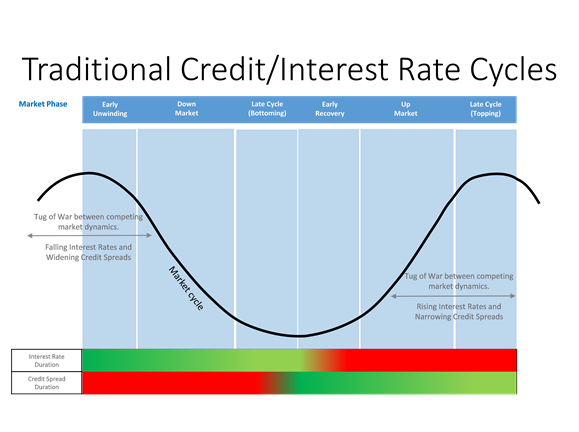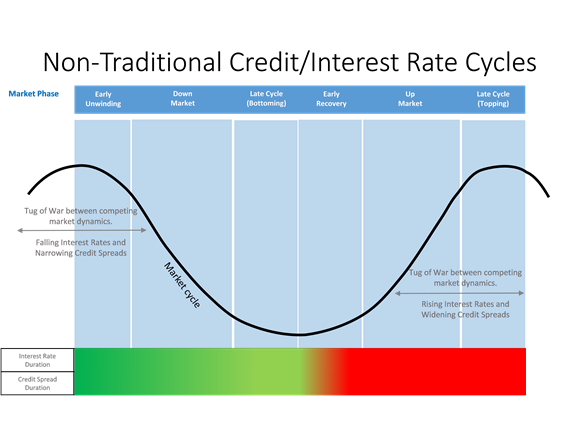The Recent Change in the New Zealand Credit Cycle May only be Temporary
One of the interrelationships often utilised by investors in more credit heavy portfolios is that interest rates will provide a level of protection against ‘risk off events’; i.e. a widening in credit spreadsi. Accordingly, the level of total risk associated with being structurally overweight credit is mitigated by the interest rate duration within a portfolio. Unfortunately for investors this relationship has broken down over the last couple of years thereby increasing the level of return volatility in such credit heavy portfolios. On a positive note for investors in New Zealand fixed income portfolios there are grounds for believing that this change in dynamics may be temporary.
One of the core sources of return enhancement within fixed income portfolios is the incorporation of a structural overweight to credit spreads. Such an overweight will tend to be more structural in nature as it provides investors with one of the more predictable premiums which can be earned in fixed income markets. This is especially true in markets such as New Zealand where the credit exposures tend to be relatively high quality; i.e. exhibit low default risk. Such high quality exposures to credit spreads means that the major risks faced by investors are the ‘mark to market’ impacts arising from movements in credit spreads. It is in this context that the traditional negative correlation between interest rates and credit spreads becomes more important factor for investors as a means of reducing overall risk within a portfolio.
Figure 1 : Credit/Interest rates through the cycle : ‘Traditional’ Relationship
Click image to enlarge
The key to the existence of the relationship is the link between monetary policy and the economic cycle. As maintaining economic stability is part of most central banks objectives there will be a tendency for central banks to manage monetary policy to “lean” against the cycle. Given such a bias, over an economic cycle, increasing bond yields are associated with central banks raising official interest rates which is indicative of stronger expected economic conditions and hence positively impacts the fundamentals for corporations and credit spreads; i.e. credit spreads contract as bond yields rise. The opposite holds for declining bond yields which in turn are associated with central banks reducing official interest rates in response to deteriorating economic growth and hence are negative for credit spreads; i.e. credit spreads expand as bond yiellds decline. The result of this tendency for central banks to “lean” against the economic cycle is the generation a negative relationship between interest rates and credit spreads over a traditional economic cycle.
While such a relationship sounds good in theory, in practice, the question we need to ask is, are credit spreads and interest rates interlinked? For New Zealand this question can be answered by considering the correlation between changes in the credit spread on the Bloomberg NZ Bond Credit Index and 10 year New Zealand government bonds. The correlation between changes in bond yields and credit spreads from April 2015 - Dec 2019 was -0.11. Such a negative correlation highlights that over this period there was, what may be termed, a traditional relationship between interest rates and credit spreads. Importantly, the statistical analysis also highlights that this relationship changed after 2019 as the Reserve Bank of New Zealand (‘RBNZ’), and central banks globally, began to implement quantitative easing to offset the deflationary impacts associated with COVID. The correlation between changes in interest rates and credit spreads from Jan 2020 – March 2022 shifted to become positive at +0.12. In contrast to the pre 2020 environment, bond yields and credit spreads didn’t act as risk diversifiers but rather their movements reinforced each other increasing overall risk within fixed income portfolios.
The change in the relationship between interest rates and credit spreads after 2019 is largely due to evolution of the RBNZ’s use of quantitative easing as a means of implementing monetary policy. More specially the channels for implementing monetary policy changed, with central banks explicitly targeting stability within financial markets themselves as a means of managing the economic cycle. Critically under the non-traditional relationship movements in credit spreads are no longer simply a by-product of the central banks use of monetary policy to “lean” against the traditional economic cycle. Rather credit spreads are being used directly by central banks as a specific target of monetary policy and a lever by which to implement and maintain accommodative monetary policy. With lower credit spreads being a specific target of monetary policy then the more accommodative central banks desire monetary policy to be the more they intervene directly within credit markets to lower the spread on such securities. Conversely, less accommodative monetary policy is likely to deliver both rising credit spreads and interest rates. It follows that under such a ‘non-traditional’ framework for implementing monetary policy investors will find that as central banks lower and then raise interest rates the interlinkage with credit spreads will differ materially from what would traditionally be expected. Rather than the negative correlation which investors may be used to, under a non-traditional approach to setting monetary policy there will tend to be a positive correlation between interest rates and credit spreads. Ironically, in contrast to the traditional cycle, in a non-traditional cycle the investor requires less, not more, interest rate duration to offset the strategic overweight to credit spreads and thereby reduce total portfolio risk.
Figure 2 : Credit/Interest rates through the cycle : ‘Non-Traditional’ Relationship
Click image to enlarge
For most fixed income portfolios the experience of the last couple of years has been one of heightened volatility in returns as the traditional relationship between interest rates and credit spreads has failed to hold. Most significantly as the RBNZ has set about normalising interest rates over the last couple of years investor returns have been hit with the ‘double whammy’ of both higher bond yields and widening credit spreads. On a more positive note for investors this change in dynamics has been largely driven by the approach to quantitative easing adopted by central banks globally where credit spreads are seen as another policy tool. As central banks move towards normalising monetary conditions, it's increasing likely that the more traditional relationship between interest rates and credit spreads will re-assert itself.
iCredit spread is broadly defined as the additional yield earned over the NZ government bond yield as compensation for the increased default and liquidity risk assumed by the investor. It should therefore be considered as the additional risk premium required by investors.

